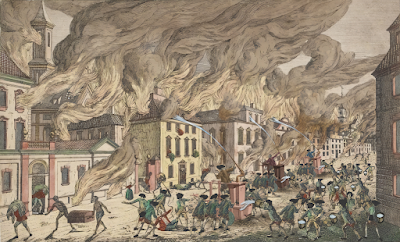SPECIAL EXHIBITION Colonial Firefighting & The American Revolution Closes 8/13 at New York City Fire Museum, 278 Spring Street, New York. www.nycfiremuseum.org and www.savingnewyork.com.
Celebration of fire fighting! The untold story of a group of volunteers, the colonial FDNY, that stood between New York and disaster during years of rampant arson, wars for North America, and the American Revolution.
1000 copies of The Art of Saving New York gifted to the first viewers of this Special Exhibition.
THE FIRE DEPARTMENT SAVING THE EXCHANGE
The FDNY rallied at the inception of the fire to save the Exchange, a large covered market with a second story meeting hall, located in the middle of lower Broad Street. They stopped the initial blaze from destroying the building even though it was just a few yards from the White Hall fire-storm. Although they saved the Exchange and the rest of the city east of Broad Street, they were too undermanned to keep the fire from blazing north.
TRINITY CHURCH BEFORE AND AFER THE FIRE OF 1776
Trinity Church succumbs to wall of flame
After the fire crossed Broadway about 2AM, it burned north towards the Lutheran Church, on the corner of Broadway and Rector Streets, the English Charity School, on Rector going down to the Hudson River, and Trinity Church. This view from just north of Trinity shows the fire as the spire of the church bursts into flames. That the fire had advanced faster than any firefighting forces could respond meant that the fire would keep burning, unstopped and unchallenged, north through the west side of Manhattan.
TRINITY CHURCH REDUCED TO FOUNDATIONS
FDNY fights to save Broadway, the Oswego Market, and St. Paul's.
As the fire burned north of Trinity, the FDNY repositioned along Broadway to save its west side north of Trinity including the Market and the Church. SOMEBODY FOUGHT THIS FIRE (Animation of 1776 fire at savingny.com.
SPECIAL EXHIBITION Colonial Firefighting & The American Revolution, 3/15-8/13 at New York City Fire Museum, 278 Spring Street, New York. www.nycfiremuseum.org Celebrate the untold story of a group of volunteers, the colonial FDNY, that stood between New York and disaster during years of rampant arson, wars for North America, and the American Revolution.
****************
This 2000 FT wall, built in 1653 gave Wall Street its name. The "palisade" style required a 3ft holed be dug for each log. Eventually the less expensive "plank" style replaced the Palisade. Yet the bulwark, like much of NYC was made of wood.
For updated scholarship, including how the fire was started and fought, there is Bruce Twickler's book NEW YORK FIREFIGHTING AND THE AMERICAN REVOLUTION: Saving Colonial Gotham from Incineration. PANEL DISCUSSION 3/21

SPECIAL EXHIBITION Colonial
Firefighting & The American Revolution, 3/15-8/13 at New York
City Fire Museum, 279 Spring Street, New York. www.nycfiremuseum.org Celebrate the
untold story of a group of volunteers, the colonial FDNY, that stood between
New York and disaster during years of rampant arson, wars for North America,
and the American Revolution.
Multimedia, video animations, and 3D models
illustrate the major events of the colonial era, including a breathtaking
video-animation of the devastating fire in 1776 that destroyed 500 buildings –
homes, churches, schools, stores, and factories. Original artworks depict the Wall
of Wall Street, the first fire engines, 1770 New York neighborhoods.
Free Celebration booklet for first 1000 attendees: THE ART OF COLONIAL FIREFIGHTING & THE AMERICAN REVOLUTION
Newsham Engine imported 1730s followed by establishing dedicated volunteers that formed the colonial FDNY. It was a little over 8 feet long and 6.5 feet high. Newsham said his engines could "...go through any Passage one Yard wide, in complete working Order..."
1. A basin held the reservoir of water filled by bucket brigade into the open top of the basin or through a pipe in the back. 2. The pump housing held the pistons, air tank, etc. and provided a platform for a firemen to stand and direct the stream of water. 3. A pair of handles allowed people on both sides of the engine to pull down vigorously to draw water into the pump. This engine could throw a stream of water forty yards.4. Unique treadles enabled people to stand and pump like a modern elliptical machine.
For more on Firefighting and The American Revolution go to savingny.com














Comments
Post a Comment